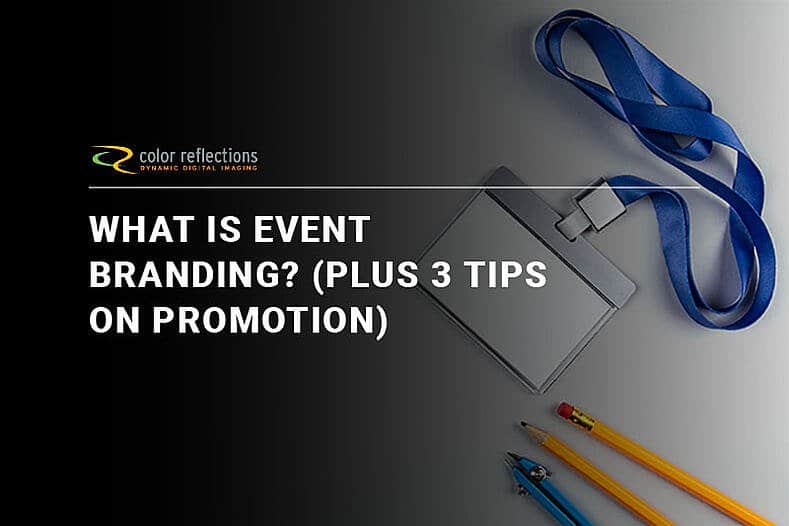Everyone knows that branding is a powerful tool, but not many people know that you can use it on your events. Event branding can make your fun an exciting event unforgettable, but how do you do it? If you’re new to event planning, or if you haven’t branded one before, you might not be sure where to start. Check out our guide to find out how to establish a unique identity for your event to make your attendees to leave them wanting more.
Want to make your next event stand out from all the rest?
Contact Color Reflections for unforgettable event graphics!
What is Event Branding?
Event branding refers to the development and promotion of a brand for events. An event’s brand should complement hat of the group hosting it, or at least have relevance to its attendees. In practice, this can mean making sure that all of your aesthetic choices fit into a single identity, from the colors you choose to the type of lighting at your venue.
Event branding can be difficult, as events encompass various products, services, and companies that might have different approaches, values, and core beliefs. The companies may fit your theme, but not entirely align with your vision; likewise, they may share your vision, but use different approaches. However, there are a few best practices you can follow to devise a brand that meets your needs.
How Do You Implement a Brand for an Event?
Implementing an event brand, though, isn’t simply about finding the right materials, colors, and symbols to represent your vision. Rather, it starts with the simple question: “what do I want my audience to feel?” Do you want an event where the audience is relaxed, or one that is loud, fast-paced, and wildly collaborative? Determining what emotion you want your audience to feel will also help to define your ultimate vision for the event.
Identifying Your Vision
When creating a vision for your event, it’s important to ask questions. These may fall into three broad categories, including what your ideal client will look like, what you hope to accomplish with the event, and what benefits you hope attendees will gain from it.
Some questions you might ask when developing your vision for an event may include:
- Who is my audience?
- Who might benefit from this event?
- What are my values?
- What do I want to represent?
- What excites me about this event?
- What do I want my customer to take away from this event?
- How will I share this event with my customer?
Designing Your Visual Brand
After that vision is hashed out and organized, you can make concrete efforts to design a visual brand. You can research images or storylines associated with your event’s intended emotion or vision. Consider different color palettes and tones, composition, fonts, and imagery to further develop the brand. This part can be time-consuming and feel overwhelming, but the work you put into your brand can translate into a more immersive and memorable experience for attendees.
However, once your logo or slogan is created and shared, it’s important to stick with it. Consistency illustrates reliability, and help to sway the audience to come to events. It’s also ideal as your purchasing branding materials, helping to unify the entire event. A lack of consistency can demonstrate instability or uncertainty, and lead to a lack of trust between you and your audience.
Purchasing Branding Materials for Events
Branding materials can include both print and digital products. Some common ones are:
Common Print-Products
- Exhibit Banners/Signage/Flags
- Posters/Flyers
- Brochures/Maps/Presentation Folders
- Business Cards
- Direct Mail Postcards
Common Digital Products
- Websites
- Apps
- Emails Digital Invites/Newsletters
- Social Media
Note: Print and digital and products does not include items such as merchandise (such as t-shirts, hats, magnets, etc.), or event equipment (such as display backdrops), which could also be used to help promote your event. Deciding on which products to purchase is primarily dependent on your intended audience. For instance, you may want to offer more digital products, rather than print products, if your audience consists of millennials.
Also, reflect on the intent behind your event. If you want your audience to have a hands-on experience, print-products may make sense. Meanwhile, if you want to promote efficiency and worldwide application, digital-products are reasonable. You must also consider logistics, such as budget and capacity. Print-products are tangible and convenient, but can be bulky and expensive. while digital products are easily shareable, but can be equally easy to overlook and forget.
How Do You Promote a Brand for an Event?
If you can create vision, design a logo, and purchasing materials, then there’s only one more vital step: promotion. Promoting an event offers an abundance of opportunities, but can also be a challenge because there are so many new channels over which to do it. It may require some trial-and-error before concluding what is and isn’t working.
Three key tips and best practices for promoting a brand for your event are:
1. Keep it Simple
Whether you’re meeting people in person, or connecting via online, networking is key to promoting your event. Networking with established businesses and others events provides you a source a stability as you’re trying to prepare for your event. At the same time, working with other upcoming business can keep your motivated. Both can lead to new ideas, resources, audience members, win-win partnerships, and additional outreach that can lead to not only one successful event, but others.
It’s important to ensure that whoever you’re networking with has a positive reputation and a shared vision that complements yours. Networking can be done in-person or via online. Websites and social media has become a popular way for people to connect, learn about, and share each other’s vision and mission. Hosting in-person or telephone meetings, getting recommendations from friends and other businesses, and attending similar events is equally helpful.
2. Network, Network, Network
Whether you’re meeting people in person, or connecting via online, networking is key to promoting your event. Networking with established businesses and others events provides you a source a stability as you’re trying to prepare for your event. At the same time, working with other upcoming business can keep your motivated. Both can lead to new ideas, resources, audience members, win-win partnerships, and additional outreach that can lead to not only one successful event, but others.
It’s important to ensure that whoever you’re networking with has a positive reputation and a shared vision that complements yours. Networking can be done in-person or via online. Websites and social media has become a popular way for people to connect, learn about, and share each other’s vision and mission. Hosting in-person or telephone meetings, getting recommendations from friends and other businesses, and attending similar events is equally helpful.
3. Always Assess Your Audience
Your audience provides the focal point for your branding efforts. You’ll need to constantly assess whether or not your branding decisions make sense to your audience or if they need adjusting. You may even want to attend similar events to learn more about your audience and what branding efforts work on them. By doing this, you’ll better understand what your audience wants, where they can be reached, and who to network with in order to make that happen.
Of course, none of this is to say that your audience and vision may change and grow. You may start an event with the idea of focusing solely on one goal and it could easily become bigger to encompass a larger, broader one. However, starting small and simple will not only help make the process logistically manageable, but also provides the space to creatively focus on your vision, ensuring that your brand, mission, and vision is consistent and strong.
This consistency and strength of your event branding will be essential to the success of your event. Taking the time to focus on it and the powerful message behind it can set the foundation for all future events. The result could be a brand that eventually needs no explanation; when someone sees it, they know that you provides a worthwhile experience.

